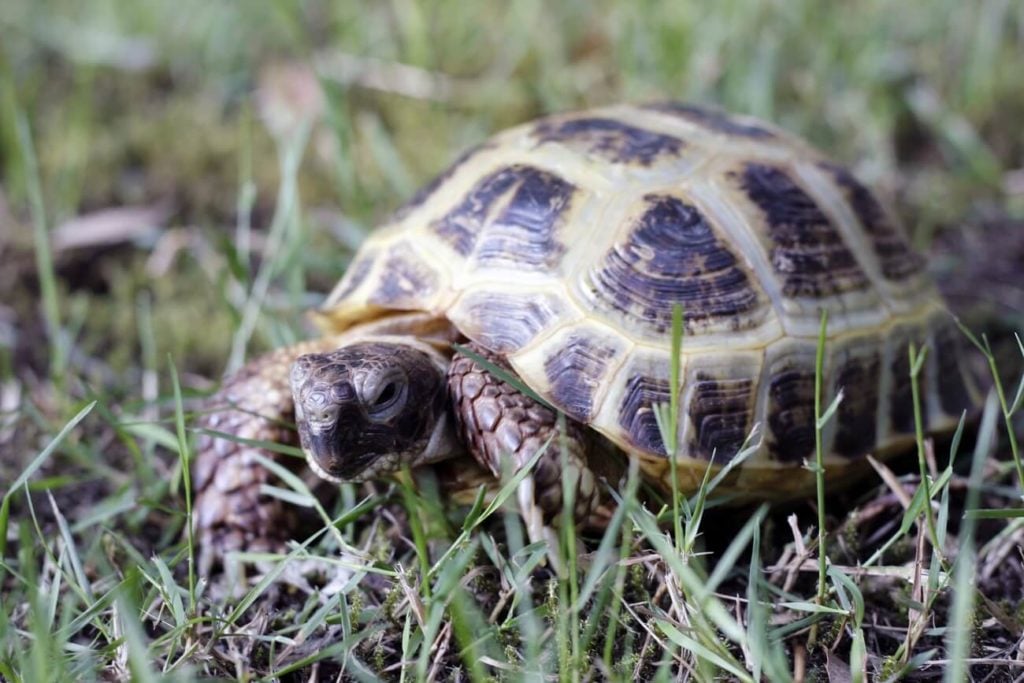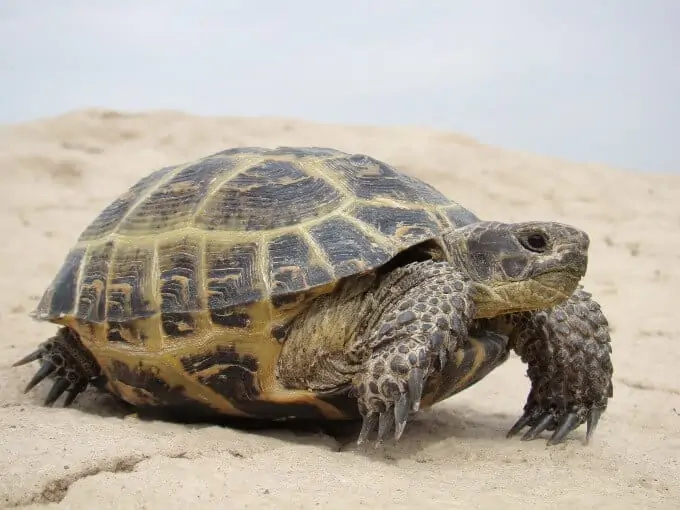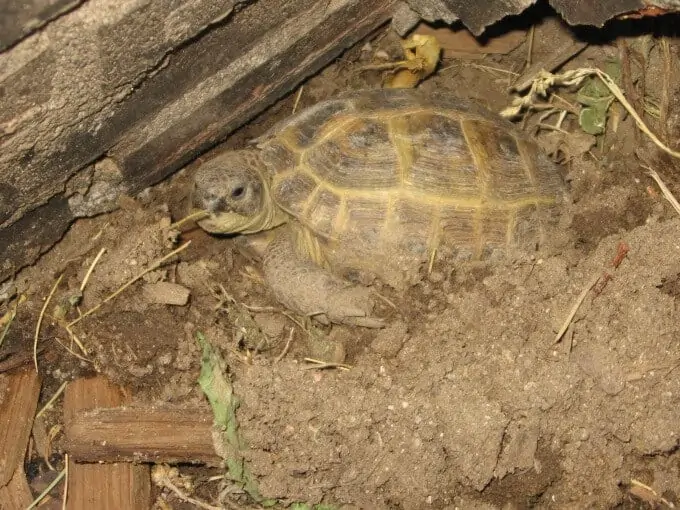How to Set Up a Russian Tortoise Habitat
The Russian tortoise has been one of the most popular pet reptiles for a while. And there are many reasons why.
They have a unique look (their digging claws), are easy to care for, and can be rather active! This makes them a great choice for pretty much any reptile-lover.
This guide covers everything you need to know about Russian tortoise care. You'll learn about their lifespan, ideal diet, enclosure, size, and much more!
Table of Contents
- Species Summary
- Lifespan
- Appearance & Colors
- Average Size
- Russian Tortoise Care
- Enclosure Size
- Ideal Habitat Setup
- Outdoor Habitats
- Indoor Habitats
- Temperature & Lighting
- Humidity
- Water Needs
- Russian Tortoise Diet & Food List
- Potential Health Issues
- Behavior & Temperament
- Handling Them
- What Do You Think?
Species Summary
Known for its active lifestyle and quirky personality, the Russian tortoise is a favorite among reptile enthusiasts.
Scientifically known as the Testudo horsfieldii, this tortoise is hardy and easy to care for. Thus, it's a goods choice for first-time reptile owners.

Russian tortoises come from arid climates in Russia, Iran, Pakistan, Afghanistan, and China. Usually, these creatures live in rocky environments at elevations as high as 7,000 feet!
Despite their affection for extreme living conditions, these tortoises make great pets. Depending on where you live, you may even be able to keep yours in a natural habitat outside!
Lifespan
The typical Russian tortoise lifespan can exceed 40 years when healthy. Like many other tortoise species, these reptiles have a long life expectancy.
To reach that milestone, these reptiles need optimal care. Without the right environment, a high-quality diet, and overall superior husbandry, these tortoises can experience stress and disease that shortens their lifespan.
Appearance & Colors
Russian tortoises are beautiful reptiles with all the hallmark features you'd expect from a land-roving tortoise. This includes the large domed shell, rough skin, and thick stubby legs.
The carapace, which is the upper part of the shell, is usually covered in shades of olive green, tan, brown, and black. The ridges are often tan while the centers of the individual scutes are darker in color.
The bottom of the shell, called the plastron, is dark as well. It may be solid black or have splashes of brown thrown in.
The skin of the tortoise is tan. You will also notice that the tortoises have darker patches all over the lower legs and head. They create an armor-like look and are usually a bit harder in texture.
Expert Tip: One interesting thing about the Russian tortoise is its feet. Each foot has four claws that the tortoise uses for burrowing and climbing. This is a feature that you don't always see in tortoises, so it's a great way to distinguish this species from others!
Males and females have some noticeable differences are well. Males have longer tails. The tip of the tail has a bony spur on the end. When hiding inside their shell, males will often rest the tail against their back thigh.
The tails on females are shorter. They also lack that hard spur on the end.
Average Size
Russian tortoises are much smaller than the massive species that people are familiar with.
The average Russian tortoise size is between eight and ten inches in length when fully grown. Adult females are almost always bigger than males. Some males don't even get past five or six inches in size.
At birth, these tortoises are usually only about an inch in length. You may see some specimens for sale around this size.
Russian Tortoise Care
Thanks to their hardy nature, Russian tortoise care isn't too hard. These reptiles are very low-maintenance and don't need much to remain happy and healthy.
That said, you still need to provide the basics!
The key to caring for these tortoises is to provide a proper environment that mimics their natural habitat in the wild. That means providing the right conditions around the clock.
To make that happen, here are some care guidelines you need to follow:
Enclosure Size
Let's start with their enclosure.
Russian tortoises are unique in the fact that you can keep them outside if your climate permits it. Generally, those living in the southern United States can do this because temperatures stay relatively warm all year long.
If you plan on creating an outside habitat, it should be at least two feet long by four feet wide. That's the bare minimum, but we recommend aiming for an enclosure that measures four feet long by four feet wide if possible.
A habitat of that size is suitable for a single tortoise or a bonded pair.

However, we know that many owners don't live in a climate that can facilitate an outdoor enclosure. In that case, an indoor habitat works too.
A good indoor Russian tortoise habitat should be a 20-gallon terrarium with at least five square feet of floor space (at least). The tank should be at least eight inches tall as well.
Ideal Habitat Setup
A lot of planning has to go into the habitat of a Russian tortoise. This is especially true if you're creating an outdoor environment, so we'll break this section into two parts.
Outdoor Habitats
The outdoor enclosure should have thick cinderblock walls that are one to two feet high. To preventing your tortoise from digging underneath the perimeter fence, make sure that it extends six inches to a foot below the surface of the soil.
Another thing to be wary of is openings in the wall. Keep the perimeter fence solid. If the tortoise can see something of interest on the other side, they will try and dig to get out. For extra security, place some large rocks along the edges of the fence.
Now, onto decorations!
Russian tortoises do best in outdoor environments with plenty of grasses and plants. Bermuda rye and fescue grass are good options. The tortoise will graze on the grass for food.
Additional plants are a must. They provide some enrichment while also creating shade. Prickly pears, bristle brushes, desert sage, and large palo verde trees do well. If you can't find any of those, any native plants will do. Just make sure that they're non-toxic and fully edible.
Hide boxes made of wood are also recommended. Have a couple of them pointed in different directions. Tortoises will use the boxes whenever they need warmth or solace from the sun. By having the boxes pointed in different directions, your tortoise can get the appropriate amount of warmth they need.
Expert Tip: We also recommend adding some rocks. You wouldn't think by looking at them, but Russian tortoises are skilled climbers. Having some flat rocks will keep the reptiles entertained.
Indoor Habitats
For indoor enclosures, keep things natural. Provide rocks, shelter, and some plants. The items you would use in an outdoor habitat are great inside as well.
On the bottom of the indoor enclosure, use a loose substrate that promotes digging. You can try cypress mulch, coconut fiber, peat moss, or even shredded paper. Cage carpet, alfalfa hay, and rabbit pellets work well, too.
Temperature & Lighting
Russian tortoises do best when daytime temperatures are around 75 to 85 degrees Fahrenheit. At night, they can tolerate temperatures as low as 60 degrees.
For indoor habitats, use a thermometer to ensure that temperatures remain stable day and night. If you need additional warmth, consider using a heat emitter.
There should be no light in the enclosure once the sun sets. These tortoises require a standard day/night cycle.
During the day, you can use the lights to add heat to the tank. Use a basking light to achieve a comfortable temperature gradient. Place the basking light on one end of the enclosure so that it heats the spot up to between 90 and 100 degrees.
Expert Tip: In addition to standard lighting, pick up some UVB lights. UVB lights are necessary for helping the tortoise metabolize calcium. They need exposure to these lights for about 10 hours a day.
In outdoor environments, your tortoise with get his or her UVB rays from the sun, so there's no need to invest in any additional lighting.
Humidity
Unlike other popular reptiles, Russian tortoises don't need super high humidity levels. They do best when levels are around 40 to 50 percent.
Whether your tortoise is outside or in a tank, it's important to use a hygrometer to check these levels regularly. Incorrect humidity levels can lead to a variety of health issues (we cover them a bit further down).
If humidity levels are too low, you can mist the environment. The plants and substrate will hold onto moisture to keep things more stable.
Many recommend creating a "humid spot" in outdoor environments just in case the tortoise needs a boost of moisture. You can do this by simply spraying down the soil on one corner of the fenced-in area.
Water Needs
Getting a large, shallow water pan is essential. Russian tortoises often use bodies of water to keep their eyes and nose clean. They may also use them to regulate body temperature and soak.
Provide a pan that's large enough for the tortoise to get in. The water should be about two inches deep.
Expert Tip: As a good rule of thumb, the water shouldn't be any higher than the point where the tortoise's carapace and plastron meet.
Make sure that you keep the pan filled with fresh non-chlorinated water at all times. Many tortoises will defecate in their dishes. When that happens, clean it out and replace the water as soon as possible.
Russian Tortoise Diet & Food List
You have a lot of options when it comes to the diet and food you give to your Russian tortoise! These reptiles are herbivores and will happily eat many plant-based foods and leafy greens.
Avoid meat-based foods and fruits. Both of those items can cause stomach problems. You should also steer clear of grains and nutrient-deficient food items, such as iceberg lettuce.
Here are some good foods that can keep Russian tortoises healthy:
- Romaine lettuce
- Alfalfa hay
- Collard greens
- Dandelion greens
- Prickly pear cactus
- Corn
- Chard
- Green or red-leaf lettuces
- Squash
- Turnip greens
- Broccoli
- Parsley
- Endive
- Spinach
- Sweet potato
- Carrots
Using several vegetables is ideal in a Russian tortoise diet. Mix things up to provide as many vitamins and nutrients as possible.
Once a week, dust a little bit of calcium and vitamin D3 supplements into the food. This step is very important for tortoises that live inside and don't have continued exposure to the sun.
Potential Health Issues
The most common health issues you might have to deal with also affect many other reptiles in captivity. These include respiratory infections and metabolic bone disease.
The former condition has to do with humidity levels. If the tortoise is getting too much humidity, the tissue in their throat and nostrils can inflame. This may lead to discharge and serious infection, so it's important to stay on top of humidity levels.
Metabolic bone disease affects Russian tortoises when they don't have exposure to UVB light. The light is necessary because it provides Vitamin D. This vitamin is responsible for metabolizing calcium.
Without enough exposure, the tortoise's bones and their shell will become weak and brittle. This could lead to an increased chance of injury and developmental issues.
Russian tortoises are also known to suffer from gastrointestinal parasites. The parasites invade your tortoise's system and leach valuable nutrients. This can lead to weight loss and malnutrition. The parasites will also cause more immediate side effects, such as diarrhea.
Luckily, parasites are easily treated with medications prescribed by your vet.
Behavior & Temperament
Russian tortoises are very active creatures. They will spend most of their days grazing on grass and plants. When they're not doing that, you will likely find them burrowing in the dirt.

The tortoises burrow to get away from the heat and create shelter. Some tortoises will also burrow to hibernate. This often occurs during the winter.
The tortoise's metabolism will slow down as they spend most of their time under the surface of the ground. They may come out every once in a while when the temperatures warm up, but most of their time will be spent sleeping.
Expert Tip: Not all Russian tortoises will hibernate. If temperatures in their habitat stay stable, the tortoise will have no reason to hibernate at all. Most captive tortoises stay active all year long.
When it comes to temperament, Russian tortoises are easy-going. They're non-aggressive and have been known to respond to owners.
Russian tortoises can live alone, in pairs, or in small groups. You might witness some slight aggression between males. They can get territorial and fight, leading to tip-overs and injuries.
If this happens, you must separate the tortoises. Aggression can occur with male and female couples as well if they're not bonded. To avoid aggression, many recommend keeping two females and a male, two females, or a bonded pair.
You can also minimize aggressive behaviors with a large environment and a lot of decorations. The decor will break the line of sight and keep things peaceful!
Handling Them
Russian tortoises aren't exactly the most cuddly pets. They tolerate handling when necessary, but most would prefer to interact with owners on the ground.
These reptiles will develop strong bonds with owners. So, most aren't going to try to bite you if you have to pick them up occasionally.
If you do this, make sure to wash your hands thoroughly afterward. Like all reptiles, Russian tortoises can carry salmonella bacteria!
What Do You Think?
Now that you've seen how simple Russian tortoise care can be, are you ready to get one for yourself?
We recommend these reptiles all the time, and always hear amazing feedback! There's something about this species that people just love.
If you're still on the fence about this species or have questions that weren't answered in our care sheet, feel free to send them over! We always love helping out our readers.
How to Set Up a Russian Tortoise Habitat
Source: https://www.reptiledirect.com/russian-tortoise/
0 Response to "How to Set Up a Russian Tortoise Habitat"
Post a Comment